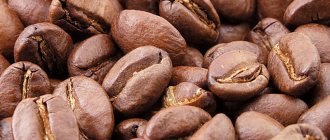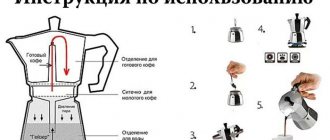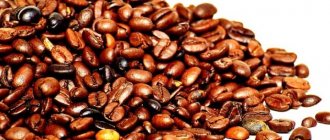Thanks to Swiss chemist Max Morgenthaler, coffee lovers have been able to enjoy an instant version for over 80 years. The ease of preparation and relatively low price made the drink extremely popular. Now it occupies 80% of the entire coffee market in Russia. You can easily get lost in the variety of options, because there are a huge variety of them in the store. In the article I will tell you how coffee is made, what it is made from and what stages of preparation the drink goes through before it hits the shelves.
Military order and universal energy drink
According to rumors, instant coffee was ordered from technologists by the military, who needed a universal drink that combined both high taste and tonic properties. Shortly before this, at the very beginning of the last century, the Japanese scientist S. Kato developed a scheme for processing roasted grains that would retain the properties of the original product, but at the same time could be stored much longer.
A few years later, the British created mass-produced instant coffee for the first time.
But it took several decades before this drink gained true popularity. This happened after Nestle offered Brazilian industrialists a convenient way to dispose of excess production. And this method turned out to be so good that very soon a good half of the coffee produced was used to make an instant analogue.
Coffee bean
The coffee bean is extracted from the red berry, the fruit of the coffee tree. It is precisely this that is the raw material for the production of the product from which several billion people prepare an aromatic drink every morning. If we talk about what coffee is made from - ground, instant, then the basis is always grain.
It can be of different varieties, sizes, degrees of maturity, and so on. Selling beans is serious business, the backbone of the economies of countries like Brazil and Colombia. Before reaching the final consumer's cup, coffee travels a lot and undergoes several technological stages of processing.
The most common variety from which most coffee products are made is Arabica Santos from Brazil.
Its largest copies are used to produce the highest quality grain product, and the rest are used for blending and creating mixtures. Brazil, as the main supplier of coffee to the world market, sells it in unprocessed form.
This is a green dried grain that is stored for a long time and has no odor or taste. Only during the roasting process does it begin to emit a familiar fragrance that invigorates you in the morning and brings you back to life in the middle of the working day.
Arabica and Robusta are two industrial varieties.
In addition to the grain itself, unscrupulous manufacturers can sell mixtures of grain, coffee bean husks, chicory, cereals under the brand name of a natural product, enrich them with flavors, enhancers, and so on.
To be sure of what you drink, you need to purchase green or already roasted coffee beans, grind them yourself and prepare a flavorful drink. If you have a coffee maker at home, or better yet a coffee machine, for example, a Delonghi, the process of preparing a drink is greatly simplified and lasts from 30 seconds to several minutes. You can prepare a variety of drinks in a coffee machine, from standard espresso to iced glass, cappuccino, raf, and so on.
History of the drink
Who was the first to come up with the idea of making instant coffee? In order not to approach the issue of authorship too formally, the researchers propose to “cut” the palm between three inventors who came to the discovery independently of each other - a New Zealander, an American and an Englishman.
The patent for the invention of instant coffee No. 3518 was received in 1890 (ahead of his colleagues) by New Zealand scientist David Strang. Meanwhile, history does not detract from the merits of another person - the American inventor, Japanese by birth, Satori Kato. The theme of his development was the creation of instant tea. Having solved this problem, but was sadly convinced that few people were interested in his brainchild, the scientist began experimenting with coffee in the hope that this direction would be more promising, and he was not mistaken: in 1899 the scientist conducted successful experiments, and soon his developments began production of the product in industrial quantities.
Around the same time, an Englishman named George Constant Louis Washington, who lived in Guatemala, also contributed to the development of the technology for manufacturing the product. Thanks to his efforts, instant coffee called “Red E Coffee” was created and, very importantly, put on the world market (the name is perceived by English-speaking people as “ready-made coffee”).
The popularity of the drink boomed during the First and Second World Wars - the coffee “semi-finished product” turned out to be indispensable in field conditions and was included in the list of products required for soldiers’ and officers’ rations in England, the USA and a number of other countries.
Another incentive for producers to produce instant coffee in large volumes was several unprecedentedly productive years for coffee beans. In order to completely process not only grains, but also “substandard” and waste, the Brazilian government in 1938 entered into an agreement with the Swiss company Nestle, funding a program to improve the taste characteristics of the product. The investment paid off - that year the Nescafe brand, known today to all lovers of an invigorating drink, was born.
In Russia, instant coffee has been a sign of wealth and “useful connections” in trade for many years. Having become more accessible, the instant drink has not lost respect for itself - it is with it that many Russians start their morning today.
The rating of the best instant coffee can be found in the publication at the link.
How to make an instant drink
Instant coffee is very popular in the CIS, although it is rarely drunk in Western Europe. How is instant coffee made and how long does the process take? The most popular and widely used method in modern production is freezing or freeze drive. First, the green grains are sorted, then fried to the desired degree and crushed.
The direct production process is divided into several stages:
- Ground coffee is loaded into a special apparatus, where it undergoes an extraction stage under the influence of a stream of hot water. In a simplified form, this process is a long brewing process in order to obtain a concentrated drink. Depending on the equipment, the process lasts from 2 to 4 hours.
- Next, some of the moisture is removed from the concentrated extract in special tanks.
- Using freeze drive technology, the extract is loaded into special sublimators, where it is sprayed onto a drum and frozen. The resulting powder can be turned into granular, flavorings and other additives can be added.
Flavoring is done with coffee oil. If you need to get a product with the aroma of caramel, chocolate, etc., use synthetic flavors that are identical to natural ones.
The latest innovation is the production of millicano granules, where instant coffee contains ground particles. This drink is more aromatic and tasty. What is instant coffee made from? These are predominantly Robusta beans.
Non-professionals tend to believe that this is a commercial move that allows them to further reduce the cost of production, since Robusta is much cheaper than Arabica. But the truth lies not so much in the price as in the special characteristics of this variety. Robusta is much richer in caffeine content. In addition, it has a pronounced bitterness and better releases its extractive components, that is, taste and aroma, into water.
In the process of producing instant coffee, the ground product is boiled for a long time, causing some of the caffeine, flavor and aromatic compounds to be lost. The high concentration of the latter in robusta allows them to be retained in the finished drink. In addition, many perceive coffee as an energy drink, while Robusta contains a lot of tonic alkaloid and most of it remains in the can.
How to choose
Freeze-dry technology is the most advanced. It allows you to better preserve the contents of the extract after processing. Externally, the sublimate resembles thin crushed tiles. Granules look like porous lumps of different shapes and sizes.
The best instant coffee is freeze-dried. It has a pleasant taste and smell, and dissolves well.
Powder brands are gradually being completely replaced from the market by sublimate and granules. Some manufacturers began to make a new type - granulated coffee with the addition of ground coffee. Microparticles of fried ground grains are placed in the granules. In this way, the product acquires a natural aroma and taste without the addition of essential oils.
- More on the topic: Rating of the best brands of instant coffee
To choose the right instant coffee, it is useful to know:
- high-quality granules should quickly and completely dissolve in hot liquid;
- the drink should not have a bready or burnt smell;
- The instant product from Arabica is much tastier than from Robusta, and it contains less caffeine.
The share of caffeine in robusta is on average 2.2%, and in arabica it is only 0.6%. Caffeine-free brands are also available. The particles are passed through a carbon filter, removing the alkaloid. But the cost of such packaging is beyond affordable.
Methods for producing instant coffee
Today, there are two types of industrial production of instant coffee. Conventionally, they can be called high-temperature and low-temperature. The first appeared earlier, and for a long time it was with its help that all the instant coffee in the world was obtained.
High temperature method
At the beginning of the process, substandard and rejected coffee beans are roasted and crushed. In this case, the particle size should not exceed 2 mm. The resulting product is poured with hot water and treated under a pressure of 15 atmospheres.
The process takes about 3-4 hours, all this time the water temperature is maintained at a high level. After this washing, the mixture is cooled, filtered, and then dried. The resulting coffee resembles a powder in appearance and is called powder coffee.
The finished product clumps into untidy lumps and sticks to the spoon. In order for the product to be more liked by the consumer and to have a marketable appearance, powdered coffee began to be subjected to additional processing.
Before final drying, the sublimate is beaten into granules or treated with steam, from which the particles also gather into dense formations.
Only after this the product is subjected to final drying. Granulated coffee looks much nicer and does not stick to dishes or stain them. That’s why granulated coffee costs more, although in essence it remains the same ersatz powder.
Low temperature method
Initially, the same process of purification, crushing, and treatment with hot water under pressure occurs. After filtration, the product is deep frozen. The resulting ice is crushed, and the crumbs are sent to a vacuum tunnel, where the ice component evaporates, bypassing the stage of water formation.
Coffee obtained in this way is called freeze-dried, that is, dehydrated. This type of ersatz costs more, which is explained by the expensive technology. However, when using it, the volume of the product does not decrease, as with the high-temperature method. We can say that by using this method, the manufacturer receives a larger volume of product, which is then sold.
It is clear that after 3-4 hours of exposure to hot water, little will remain of the aroma and taste of the grains. Try simply boiling ground coffee for 3 hours, and we are sure that the resulting “drink” will not be too to your liking. Therefore, in order to improve and correct the taste of instant coffee, special fragrances, oils, flavoring additives and other achievements of the chemical industry are added to ersatz at different stages of production. By the way, granulated and freeze-dried coffee is also tinted so that the particles acquire an attractive shade.
The difference between expensive varieties is that they have added natural oils and flavors obtained from real grains. Cheap varieties use synthesized additives. But even the most “elite” varieties of instant coffee are made from cheap beans and residues from coffee production.
Noteworthy is the fact that the exact recipe of the product is classified. Manufacturers vigilantly guard their secrets, so it is impossible to say exactly what a person drinks under the guise of instant coffee.
Freeze dried coffee
Outwardly, it looks almost the same as granulated, but is prepared using a fundamentally different technology: the coffee extract is frozen at a very low temperature, then it is dehydrated in a vacuum and crushed into crystals.
This is the most expensive method of producing instant coffee, allowing you to preserve the beneficial properties, taste and aroma of the beans.
Glass jars are always used for packaging freeze-dried coffee - they preserve the product better.
How to choose a quality product
Every buyer wants to buy high quality products. What you need to pay attention to when buying an instant drink:
- Natural coffee and coffee drinks can be displayed on one shelf in a supermarket. Make a choice in favor of a product whose label indicates that it is 100% coffee. This information suggests that the instant product is completely natural.
- Choose products from a well-known brand. Manufacturers that have established themselves in the coffee market will not supply a low-quality product.
- It is better to purchase instant coffee in glass containers or soft bags.
- The packaging must indicate all the necessary information: manufacturer and distributor, production date, expiration date.
- The packaging must be hermetically sealed. The granules in the container must have the same shape, without powder or large particles.
Many consumers have repeatedly heard about the dangers of instant coffee, but I would like to note that high-quality products are not inferior in taste and beneficial properties to ground coffee. If no chemical additives (dyes, preservatives and other harmful compounds) were used during the production process, we can confidently say that this product is 100% natural. Another thing is that each person has individual taste preferences, therefore, some prefer brewed ground coffee.
What is the difference between instant coffee and natural coffee?
Unfortunately, the answer to this question does not include the positive properties of an instant drink. Compared to natural it:
- made from low-quality raw materials, which may contain impurities;
- it contains essential oils;
- All kinds of chemical additives are used.
Beverage production technology
Let's figure out how this drink is made:
- Green grains are taken, unsuitable for anything else;
- Fry for 15 minutes and grind, not too finely;
- Coffee oils are added to add flavor;
- The resulting mass is loaded into huge extractors;
- The drink is boiled and coffee is obtained using boiling water;
- The entire volume is poured into huge turbines;
- Part of the liquid is removed, thickening the product and obtaining a concentrate;
- Spray and create granules using cold freezing technology;
- Packaged, adding sugar, flavorings, stabilizers, etc.
If you remove essential oils and various chemical additives from the production scheme, the final product will have neither taste nor smell. This is such a flaming black mass that you don’t even want to drink. And only the addition of these components allows you to disguise the drink as something acceptable.
Robusta and Arabica beans are used to make coffee.
, often giving preference to the first option. It is this variety that contains the most caffeine, and during production the coffee loses some of its reserves. And these raw materials are a little cheaper, which allows you to reduce costs and get more profit.
In this video, technologist Marina Lozhkina will talk about the process and ingredients of ground coffee production:
How much caffeine is in instant coffee?
One cup of coffee contains 60-80 mg of caffeine (for ground coffee - 80-150 mg). There are brands on the market that produce decaffeinated (decaffeinated) instant coffee.
There are several ways to decaffeine:
- CO2 extraction (removal of caffeine with carbon dioxide);
- Chemical (dissolution and evaporation of acetate with ethylene);
- Carbon filters (caffeine extraction by prolonged soaking in water and passing through special filters).
It is impossible to extract all the caffeine from the beans; a small part of it remains in the product. The maximum permissible value of caffeine content in decaffeinated coffee is 1-3%. The extracted caffeine is used in pharmaceuticals. For example, for the production of the well-known headache tablets Citramon.
There is natural decaffeinated coffee - a crop of trees that do not contain this substance. It is marketed under the Decaffito brand.
How many calories are in instant coffee?
Despite all its negative properties, coffee, like any other drink, contains virtually no calories :
- 100 grams of the finished product contains only 2 calories;
- If you do not want to eat dry coffee, it is better to brew it - the indicators will change slightly;
- An average cup of instant coffee, without sugar, will contain 4 calories;
- A sweet drink will take up all 8 calories;
- If the volume of the drink is more or less than 250 ml, the calorie content changes proportionally.
A couple of cups will not affect your figure in any way, and it will not satisfy your energy hunger.
The situation is exactly the same with other drinks; the same tea contains virtually no calories. The situation will change if, in addition to sugar, you add cream, milk, vanillin or something else to your coffee. Here you will have to separately calculate the calorie content of each supplement and then add up the resulting result.
In some cases, a mug can cost 400-500 calories, which is comparable to a bar of chocolate. The low calorie content of the grains themselves and the finished instant drink does not in any way affect the number of calories contained in the same sugar or cream. This should not be forgotten by those who are on a diet and trying to get rid of excess weight.
Making Egyptian coffee with foam
Baristas often prepare this type of coffee with foam in Egyptian coffee shops. Moreover, recipes from different specialists may differ.
For the process you need:
- two containers (cups or coffee glasses)
- instant coffee - 15 grams;
- sugar - 3 small spoons;
- hot bottled water - 120 ml;
- warm milk - 80 ml;
- tube - 1 pc.
Step-by-step recipe for making foamy coffee:
- Pour the instant product (half a serving) and sugar into the first cup, and pour some water at room temperature into it.
- Cut the cocktail tube at the end and bend it so that you get helicopter blades.
- Lower the cut end into the cup, pinch the upper end with your palms, and begin to rotate.
- Over time, this process results in the formation of a creamy composition.
- Now make coffee with milk in the second cup. First, pour in the remaining coffee, sugar, hot water, and milk.
- Carefully place the foam on top. The drink is ready to drink.
For variety, vanilla, chocolate chips, cinnamon, etc. are added to this drink.
This foam is used not only for coffee drinks, but also for decorating baked goods.
Harm of instant coffee
A lot has already been said about the dangers of instant drinks. It is certainly known that instant coffee has a negative effect on the cardiovascular and central nervous system, causing anxiety and depression. It can cause blood pressure surges and heart disease. One of the most unfavorable “effects” is oxidation of the gastrointestinal tract, which can provoke the development of ulcers, gastritis and other more serious diseases.
The deposition of kidney stones is another unpleasant surprise for lovers of daily consumption of the drink. It also actively removes water and nutrients from the body, in particular calcium. This threatens increased fragility of bones, joints and associated diseases.
Doctors recommend drinking a glass of water after each cup of this drink. The product has a very bad effect on the skin, inhibits collagen production and accelerates the aging process.
Video: How instant coffee is made
Sources:
https://sostavproduktov.ru/produkty/napitki/bezalkogolnye/rastvorimyy-kofe
https://fitseven.ru/pohudenie/diety/kak-delayut-rastvorimiy-cofe
https://kofechay.com/obshchaya-informaciya/chego-delayut-kofe
https://storymil.com/rastvorimyj-kofe-kak-i-iz-chego-delayut/
https://kofella.net/vse-o-kofe/kak-delayut-rastvorimyiy-kofe.html
https://foodsinfo.ru/obshhie-voprosy/kak-delayut-rastvorimyj-kofe/
https://1-kak.ru/499-iz-chego-delayut-rastvorimyj-kofe.html
Iced coffee
In order to properly prepare the base for this type of drink, you need to mix 1 teaspoon of coffee and 2 teaspoons of hot water. After this you get a thick paste.
For a richer taste, you can add the following components:
- cocoa powder or chocolate syrup;
- vanilla extract (for a sweeter taste);
- a pinch of spices;
- flavored cream in dry form.
Next, take a glass of cold water and mix with the resulting coffee slurry. To get a rich, creamy taste, use milk instead of water.
The next step is to pour the resulting coffee syrup onto the ice. You need to pour as slowly as possible. You can drink iced coffee without adding cream, or you can add the desired amount on top of the ice. The amount of milk you add should be determined based on your preference.
The drink should be consumed immediately after preparation to prevent the ice from melting. You can drink it through a straw or as usual.











